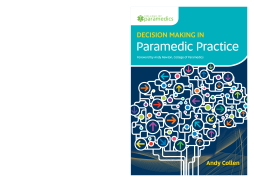
Additional Information
Book Details
Abstract
In this new book, Andy Collen offers a wealth of knowledge about the importance of decision making in healthcare practice to reduce clinical risk and improve outcomes for patients. The text explores the role of the modern paramedic and of the paramedic as a critical thinker. It offers a unique perspective on clinical decision making, highlighting important aspects such as the balance between intuition and experience as well as professional issues.
Table of Contents
| Section Title | Page | Action | Price |
|---|---|---|---|
| Title | i | ||
| About the Author | iii | ||
| Contents | vi | ||
| Foreword | viii | ||
| Chapter 1 Paramedic Practice: The Changing Patient Profile in Urgent, Emergency and Critical Care | 1 | ||
| Chapter Objectives | 1 | ||
| Introduction: The Development of the Paramedic | 1 | ||
| The Evolving Role of Paramedics and Changing Practice Settings | 4 | ||
| Patient Demography and Epidemiology | 6 | ||
| Professional Conduct and Standards | 11 | ||
| The Paramedic’s Role as an Allied Health Professional | 12 | ||
| Conclusion | 13 | ||
| Reflective Exercises | 14 | ||
| Chapter 2 Professional Issues | 15 | ||
| Chapter Objectives | 15 | ||
| Introduction | 15 | ||
| Professional Regulation and Standards | 16 | ||
| Standards | 17 | ||
| Fitness to Practise and Sanctions | 18 | ||
| Being Confident in Practice | 19 | ||
| Professional Identity | 19 | ||
| Biomedical Ethics | 20 | ||
| Putting the Patient First: Ethical Considerations in Practice | 20 | ||
| Non-maleficence | 20 | ||
| Beneficence | 21 | ||
| Respect for Autonomy | 21 | ||
| Justice | 21 | ||
| Patient-centred care | 22 | ||
| Confidentiality | 23 | ||
| Competence and Confidence in Practice | 25 | ||
| Professional Insight | 26 | ||
| Summary | 27 | ||
| Conclusion | 27 | ||
| Reflective Exercises | 28 | ||
| Ethics Bibliography | 28 | ||
| Chapter 3 The Evolution of the Paramedic as a Critical Thinker | 30 | ||
| Chapter Objectives | 30 | ||
| Approach to Critical Thinking in Everyday Life and Paramedic Practice | 30 | ||
| Decision Making, Values and Healthcare Practice | 32 | ||
| Barriers to Critical Thinking | 35 | ||
| Egotism vs Humility | 38 | ||
| Selfishness: Emotional Influence and Personal Values | 39 | ||
| Intuition and Experience in Critical Thinking | 43 | ||
| Decision Point Management: Taking Control at Each Stage | 44 | ||
| Summing Up: Moving from ‘What’ to ‘Why’ | 47 | ||
| Conclusion | 48 | ||
| Reflective Exercises | 48 | ||
| Further Resources | 49 | ||
| Chapter 4 Decision Making Theory: Human Factors, Dilemmas and Conundrums | 50 | ||
| Chapter Objectives | 50 | ||
| Introduction | 50 | ||
| Defining Autonomy | 51 | ||
| Human Factors | 52 | ||
| Definition of Human Factors | 54 | ||
| Checklists and Structured Communication | 69 | ||
| Human Fallibility and Biased Thinking: Learn Before You Make Mistakes | 70 | ||
| Anchoring | 71 | ||
| Availability | 71 | ||
| Conjunction Bias | 72 | ||
| Optimism and Loss Aversion | 72 | ||
| Conclusion | 79 | ||
| Reflective Exercises | 80 | ||
| Human Factors Bibliography | 81 | ||
| Chapter 5 The Garden Path Test: Putting Decision Making into Practice – Intuition, Experience, Hypotheses, and Deduction | 82 | ||
| Chapter Objectives | 82 | ||
| Introduction | 82 | ||
| Intuition – The Enemy Within? | 84 | ||
| Experience | 86 | ||
| Reflective Question | 90 | ||
| Hypotheses: Developing and Testing Ideas | 92 | ||
| Conclusion | 95 | ||
| Professional Practice and Learning Pointers | 96 | ||
| Reflective Exercises | 96 | ||
| Chapter 6 The Cognitive Continuum: Enhancing your Decision making Skills | 97 | ||
| Chapter Objectives | 97 | ||
| Introduction | 97 | ||
| Defining the Cognitive Continuum | 98 | ||
| Information Processing | 100 | ||
| Professional Judgements | 102 | ||
| Converting Experience into Hypothesis Development | 104 | ||
| Mitigating Risk: Management vs Avoidance | 105 | ||
| Conclusion | 110 | ||
| Reflective Exercises | 110 | ||
| Web Links | 111 | ||
| Chapter 7 Case-Based Discussion (Case Studies, Reflection, Action Learning) | 112 | ||
| Introduction | 112 | ||
| Case Studies | 113 | ||
| Case Study 1: 32-year-old Female with Headache | 113 | ||
| Case Study 2: 45-year-old Male with Productive Cough and Chest Pain | 117 | ||
| Case Study 3: 78-year-old Female Fallen with a Minor Head Injury and Taking Anticoagulant Therapy | 121 | ||
| Case Study 4: 29-year-old Female with Respiratory Illness | 125 | ||
| Case Study 5: 36-year-old Female with Abdominal Pain | 130 | ||
| Appendix | 135 | ||
| Glossary | 137 | ||
| Bibliography | 143 | ||
| Index | 151 |
